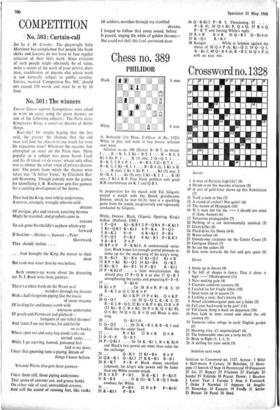Chess no. 389
PHILIDOR
Black White 8 men 8 men
A. Bottacchi (1st Prize, L'Alfiere di Re, 1921). White to play and mate in two moves; solution next week.
Solution to no. 388 (Blake): B – B 7, no threat. 1 . . . R – K 3; 2 Kt – B 5. 1 . . . R – B 3; 2 Kt X Kt P. 1 . . . R (3) else; 2 Q– Q 5. 1 . . . B–K 3; 2 B x P. 1 B–B 3; 2 Q–R 7. 1 . . .
B – K 1; 2 Kt–B 5. 1 B–B 4 ch; 2 Kt X B.
1 . . . B else; 2 Kt X Kt P. 1 . . . Kt (7) any; 2 Q–K 4. 1 ... Kt (8) any; 2 Kt – K 2. 1 R (8) any; 2 Kt x B P. Fine block problem with good R/B interferences on K 3 and Q B 3.
In preparation for his match with Tal, Gligoric played a match with the Dutch grandmaster
Donner, which won 64--31; here is a sparkling game from the match, imaginatively and vigorously conducted by Gligoric.
White,Donner. Black, Gligoric. Opening, King's Indian. (Holland, 1968.) 1 P–Q4 Kt–KB 3 2 P–QB 4 P–KKt 3 3 Kt–QB 3 B–Kt 2 4 P–K 4 P–Q 3
S B – K 2 0-0 6 B–Kt 5 P–B4
7 P–Q 5 P–K3 8 Kt–B3 P–KR 3 9 B–R4 PXP 10 BP X P P– K Kt 4. A controversial varia- tion; Black hopes for enough central pressure to make up for the weakening of his king's wing. 11 B–Kt 3 Kt–R4 12 Kt–Q2 Kt x B 13 RP x Kt Kt–Q2 14 Kt–B4 Q–K 2 15 Kt–K3 Kt–B3 16 P–B 3 R–Kt 1
17 P – K Kt 4? . . . a fatal miscalculation. He should play 17 P – Q R 4 or else 17 Q– B 2 strengthening the centre and preparing 0 –0 –0.
17 P – Kt 4! 18 Kt x P . . . Or 18 B x P, P–R 3; 19 B – K 2 or Q 3; 20 R x P.
18... KtXKP! 19 PxKt QXKP
– I; 2 20 Q–Q 3 ... Or 20 Q–Q 2, RK 1
R – R 3, B –Q 5; 22 Kt x B, P x Kt; 23 R x P (23 Kt – B 5, B x Kt; 24 P X B, Q x Kt P), Q x Kt; 24 Q x Q, R x Q and Black is win- ning. 20... Q–Kt5ch
21 Q – Q 2 ... Or 21 K – B 2, K R – K 1 and Black has the upper hand. 21 ... RxKt 22 BxR QXB 230-0-0 Q – R 5 Q
24 P– Kt 3 ... Or 24 K–Kt 1, B x K Kt P and Black's two pawns are more than value for exchange. e.
24 ... Q–K 5 25 Kt–B4 B X P 26 QR–K 1 Q–Kt3 27 KR–B1 B-13 1 28 R – K 7 P– B 4! Black shows • excellent judgment, his king's side pawns will be faster than any White counter-attack. 29 R x RP P–B 5 30 R–K 1 P–Kt 51
31 R – R 8 . . . 31 R (1)–K 7, B – Q 5 leads nowhere for White.
31 ... P–B 6 32 P x P P–Kt 6! 33 R–Ktl P–R4 34 Q – K Kt 2 P – R 5. Threatening 35 P–R 6!; 36 Q x Kt P, Q x Q; 37 R x Q, P – R 7! and forcing White's reply.
35 R x B R x R 36 Q–R 3 Q–Kt 4 ch 37 K–Q1 R–K1 38 Resigns . . . White is helpless against the threat of 38 Q x P ch, Kt – Q 2; 39 Q – Q 5, R – Kt 2; 40 Q – R 8 ch, K – B 2; 41 Q x P ch with an easy win.






































 Previous page
Previous page